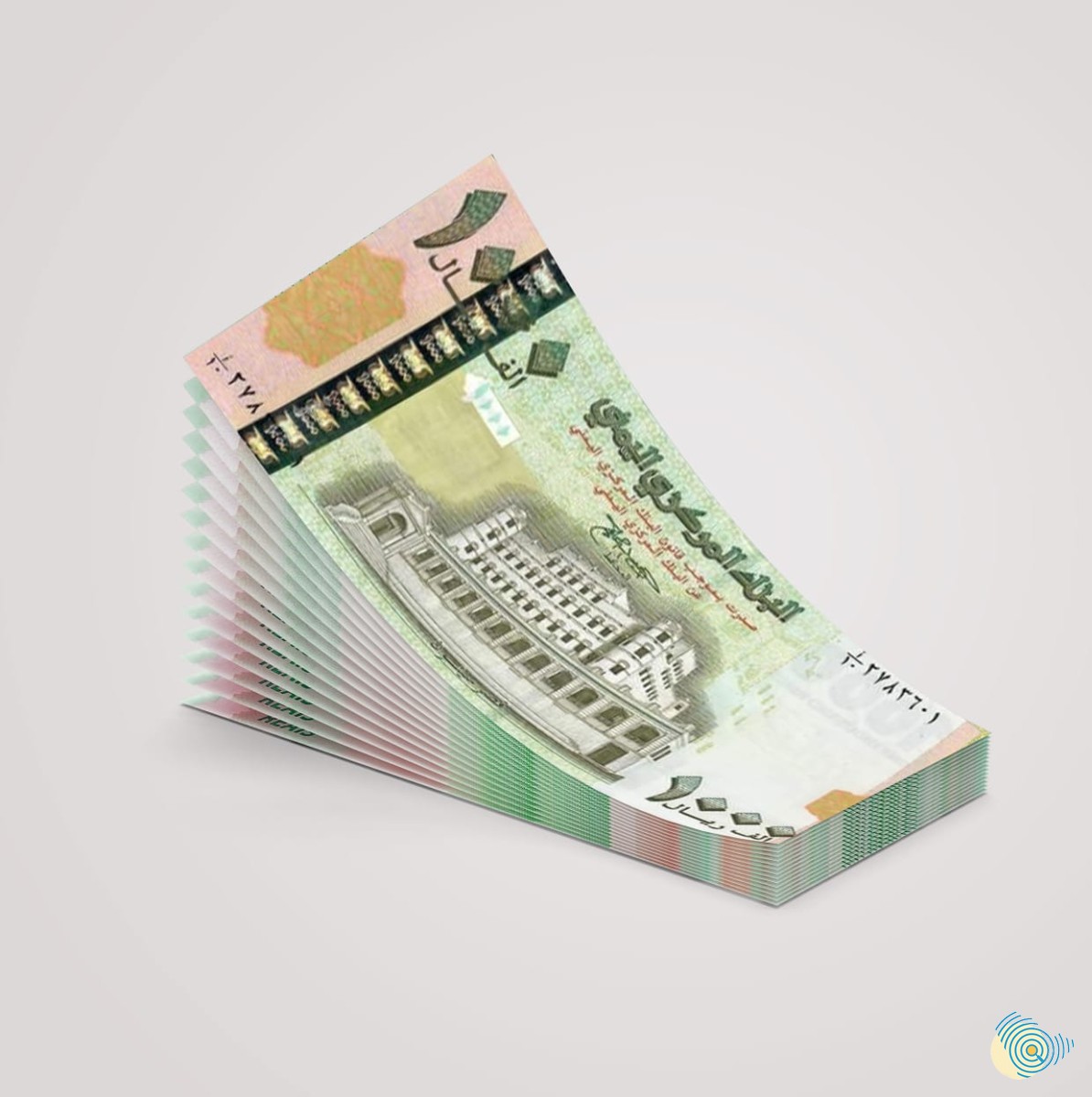Critical condition: Unraveling Exchange Rate Fluctuations in Yemen
- 09 Sep 2023


The determinants of exchange rate trends and volatility are contentious in banking literature. They encompass real economic factors like inflation, GDP, budgetary conditions, and trade volumes, along with monetary elements such as interest rates, money supply, foreign reserves, and central bank interventions. Non-economic factors, including politics, psychology, expectations, pressures, wars, and political issues, also influence exchange rates.
The factors contributing to the national currency's depreciation in Yemen have accumulated over time, with the most prominent ones including:
Consequences of the Houthi Coup: The Houthi group's seizure of power in September 2014 triggered a cascade of adverse effects, including armed conflict, widespread destruction, and significant economic imbalances. The country's foreign currency resources dwindled due to declining oil exports, halted gas exports, and decreased fish and agricultural production revenue. The coup disrupted tourism, crippled local production, and led to a substantial reduction in foreign aid, grants, loans, and international assistance. Moreover, the Houthis gained control over most of the available foreign reserves, further exacerbating the depreciation of the local currency.
Eroded Trust in the Banking System: In mid-2016, Yemen's banking sector experienced a severe liquidity crisis, primarily driven by a loss of confidence in the banking system. This lack of trust emerged following the Houthi takeover and their control over the Central Bank of Yemen. Consequently, cash liquidity in Yemeni riyals began to flow toward money changers instead of remaining within banks. This led to a significant accumulation of cash reserves outside the formal banking sector, disrupting the normal monetary cycle due to the inability to channel these funds back to the Central Bank of Yemen.
Recovery of the Parallel Economy and the Black Market: The Yemeni economy has witnessed the unchecked proliferation of currency speculators operating in an unregulated environment. Hundreds of exchange shops and local money transfer networks have emerged, engaging in cutthroat competition to offer the most favourable rates for purchasing foreign currencies. These entities cater to various actors benefitting from the ongoing conflict, facilitating the conversion and smuggling of funds out of Yemen. The Houthis, maintaining control over the Central Bank in Sana'a after the legitimate government transferred its operations to Aden in August 2016, effectively established their own parallel banking system. This division of monetary and financial authority complicated the economic landscape, distributed responsibilities unevenly, and escalated economic tensions.
Government Response and Policies: The Houthis' control over a significant portion of the country's resources, coupled with the failure of some parties aligned with the legitimate government to contribute state revenues to the Central Bank, has led to a decline in public revenues. These revenues no longer cover the essential expenses of the legitimate government, resulting in a widening budget deficit. To bridge this gap, the government has resorted to printing and issuing more currency, which, given the wartime economic conditions, triggered a record-high exchange rate for the US dollar in early 2018, surpassing 500 riyals per dollar. In response to these challenges, the Kingdom of Saudi Arabia announced a $2 billion deposit to the Central Bank of Yemen to support the local currency.
Disruption of the Centralized System and Diverse Monetary Policies: A critical factor contributing to the devaluation of the Yemeni riyal was the Houthis' decision to ban the circulation of the new currency edition at the end of 2019. This decision had numerous adverse economic consequences, including creating shortages and imbalances in the money supply across different governorates. It also led to the leakage of newly printed banknotes from Houthi-controlled areas to government-controlled areas. Additionally, the ban fueled currency speculation, resulting in varying exchange rates for the Yemeni riyal between the old edition in Houthi-controlled areas and the new edition in government-controlled areas. This currency dichotomy has led to a substantial increase in exchange rates in government-controlled areas, reaching a difference of 250% compared to Houthi-controlled areas. Moreover, it has raised the costs of remittances from government-controlled areas to Houthi-held territories, particularly to Sana'a.
The significant Saudi deposit, as mentioned earlier, played a crucial role in stabilising exchange rates while covering the import costs of essential commodities at prices below the market rate. The exchange rate remained relatively stable in areas under the legitimate government's control, albeit around 20% higher than in Houthi-controlled regions. Nevertheless, occasional fluctuations occurred due to psychological factors manipulated by currency speculators, influenced by local political developments in 2020. Notably, the political crisis between the Transitional Council and the legitimate government emerged during this period, compelling the legitimate government to depart from Aden. Concurrently, the onset of the COVID-19 pandemic coincided with the depletion of the Saudi deposit, casting a shadow over exchange rates. Consequently, the Yemeni riyal began to gradually depreciate again, with the US dollar surpassing 800 riyals per dollar by the end of 2020.
In early 2021, following the publication and circulation of a report by international experts accusing the Yemeni government and its central bank of corruption and money laundering in their use of the Saudi deposit (later retracted in a subsequent 2022 report), confidence in the Central Bank of Yemen started eroding within the exchange market. This loss of trust led to a rapid spike in the dollar exchange rate, averaging 870 riyals per dollar in February 2021—an increase of 70 riyals within that month.
Despite the Central Bank of Yemen's introduction of a novel intervention approach in the exchange market via currency auctions and some reform initiatives by the legitimate government, the Yemeni riyal experienced its most severe depreciation in history. At the outset of December 2021, the US dollar surpassed an alarming threshold of 1,700 riyals per dollar. It was during this period that announcements were made regarding the restructuring of the Central Bank of Yemen's Board of Directors and the replacement of the Shabwa Governor.
Consequently, driven by these decisions and the revelation of an impending Saudi deposit by Prime Minister Dr Moeen Abdul Malik, the exchange rate for the US dollar plummeted from 1,700 to below 1,000 riyals per dollar. It then maintained fluctuations within the range of 1,100 to 1,250 riyals per dollar during the initial three months of 2022.
Following the declaration of power transition in Yemen to a Presidential Leadership Council in April 2022, concurrently announced with Saudi-Emirati support amounting to 3.3 billion, the dollar exchange rate experienced a decrease, reaching approximately 900 riyals per dollar. Subsequently, it stabilised at an average of 1,170 riyals per dollar for the remainder of the year, notwithstanding numerous economic and political events and developments. One of the most significant occurrences was the Houthi drone attack on oil export ports towards the end of 2022. This attack deprived the legitimate government of a vital and sustainable resource that typically supplements the state treasury with hard currency, essential for covering import expenses and fulfilling domestic obligations.
While the Central Bank persevered in conducting auctions at prices closely aligned with market rates, the dollar exchange rate sustained an average stability of around 1,250 during the initial months of 2023. Regrettably, this stability proved transient, with the dollar's value surging again, causing the Yemeni riyal to depreciate by more than 11%.
Over the past nine months, since the onset of Houthi attacks on oil export ports, the Yemeni government has incurred losses exceeding $1.5 billion, as stated by the Central Bank of Yemen's Governor during a recent TV interview. Furthermore, due to the redirection of oil and cargo ships to the port of Hodeidah, Yemen's government has forfeited more than 700 billion riyals in taxes and fees that formerly transited through the Aden port before the shift to Hodeidah.
An unprecedented surge in foreign exchange demand was primarily driven by the need to cover Hajj expenses in 1444.
Delays in Saudi Arabia's disbursement of support for the national budget aimed at compensating for the halted oil revenues. These delays persist despite ongoing negotiations regarding this crucial financial aid.
For anyone monitoring exchange rate developments in Yemen from the wartime period to the present day, it becomes apparent that psychological factors, currency speculators, political events, and the influence of social media are fundamental drivers that not only impact exchange rates but often take precedence over real economic factors—both financial and monetary.
Moreover, it is evident that currency speculators, in conjunction with the Houthis and other political factions operating within the framework of legitimacy, exploit adverse news to exert upward pressure on exchange rates in regions controlled by the legitimate government. Their objective is to realise financial gains for speculators and reap political advantages for the Houthis and affiliated groups.
To achieve exchange rate stability, it is imperative to depoliticise the central bank and allow it to function independently, free from the influence of political tensions.
The legitimate government, in collaboration with the international community, must recover its lost financial resources, including halted oil revenues due to Houthi attacks and resources seized by the Houthis from various state institutions like telecommunications, tax, customs, and funds redirected through the port of Hodeidah. The government should work to regain its legitimacy in this regard.
In cases of delays or obstacles to the above measures, the legitimate government should expedite the process of resource compensation, particularly in light of ongoing discussions in Saudi Arabia regarding budget support. Saudi support can serve as compensation for the Yemeni government to fulfil its essential obligations and necessary expenditures, ultimately facilitating comprehensive peace negotiations with the Houthis.
The legitimate government and its central bank must actively engage in media, educational, and awareness campaigns targeted at citizens and market participants. This approach aims to undermine the influence of currency speculators and anti-legitimate factions in the exchange market while controlling the spread of rumours and negative news. Such efforts will contribute significantly to achieving exchange rate stability and overall price stability.
The aforementioned factors persisted from the beginning of May until the end of July. By Eid al-Adha, the dollar exchange rate had soared to 1,372 riyals per dollar.
Although most of these factors have since been addressed, with the Central Bank refuting misleading reports about the state's insolvency, foreign currency reserve depletion, and the introduction of freshly printed money, confirming its commitment to conducting currency auctions and meeting salary obligations despite the halted oil exports and inability to cover the deficit from inflationary sources, additionally, the bank received the second batch of Special Drawing Rights.
Political tensions among the factions representing the legitimate government also eased, with the Governor of Aden reversing the decision to withhold revenues. Furthermore, the Hajj season concluded for the year, returning currency demand to its previous state. An agreement with the Saudi side for the Yemeni government to receive the first batch of budget support is nearing completion. However, despite these developments, the exchange rate has remained elevated under the current central bank management, gradually increasing once again after the Eid al-Adha holiday, with the dollar exchange rate recently surpassing the 1,500 riyals per dollar threshold.
The stated views express the views of the author and do not necessarily reflect the views of the Center or the work team.
Comments